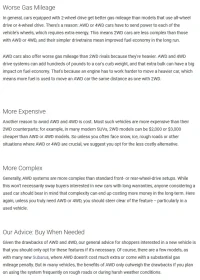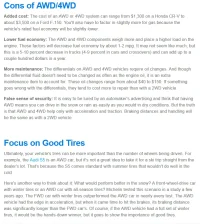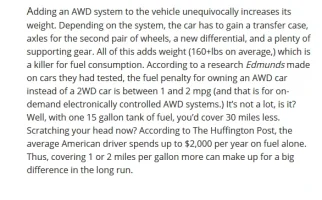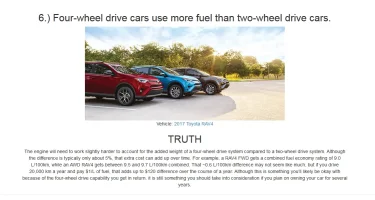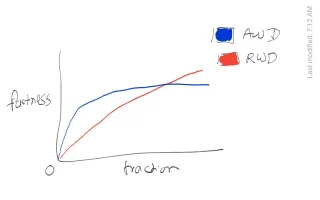You are using an out of date browser. It may not display this or other websites correctly.
You should upgrade or use an alternative browser.
You should upgrade or use an alternative browser.
AWD or RWD? (split from new member question)
- Thread starter Menissalt
- Start date
TimS
Member
Our Advice - Buy when needed
Given the drawbacks of AWD and 4WD, our general advice for shoppers interested in a new vehicle is that you should only opt for the features if it's necessary. Of course, there are models, as with many Subarus, where AWD doesn't cost much extra or come with a substantial gas mileage penalty. But in many vehicles, the benefits of AWD only outweigh the drawbacks if you plan on using the system frequently on rough roads or during harsh weather conditions.
Hmmm, maybe I am crazy, but that's pretty much what I've been saying from the start.
And it's interesting to note the part I bolded. That part would obviously apply to the Stinger models in question, since the AWD doesn't cost much extra, nor does it come with substantial mileage penalties. As I've said from the start - you're referring to AWD in general - I am addressing the Stinger -in particular-, because the Stinger was what the OP was asking about - not AWD 'in general'. The difference between the Stinger AWD and RWD fuel economy has been proven - and reported - to be 'small to none'.
-Tim
______________________________
TimS
Member
I also find it interesting that you edited out some important info from the Edmunds article you quoted. Namely, the BENEFITS provided by AWD:
The Textbook Cases
There are some cases when you should give AWD and 4WD serious consideration: for example, if you live near or spend time in places with unpaved dirt roads. Similarly, if you live in places where it rains or snows for many months out of the year, AWD or 4WD will help with traction and should be high on your list of must-have car options.
But for some people, the choice may not be that clear-cut. Here is a list of pros and cons to help you make a better decision.
Pros of AWD/4WD
Better acceleration: An AWD or 4WD vehicle can accelerate better than a two-wheel-drive vehicle in inclement weather. "The advantage provided by AWD is mainly in the acceleration, as the traction needs will be equally distributed among all four tires," says Cyrille Roget, a spokesperson for Michelin North America. On a car with front-wheel drive, "the need for traction will be transmitted only on two tires," adds Roget.
Helps with traction and towing: A 4WD truck's improved traction can help if you are towing from a wet, steep boat ramp, says Dan Edmunds, director of vehicle testing for Edmunds. Similarly, if you go camping off-road in dirt or in sandy areas, a vehicle with AWD or 4WD will reduce your chances of getting stuck. But you don't need these systems if towing on dry, paved roads and camping in developed spots are your thing, says Edmunds.
Improves dry handling: This benefit applies only to AWD vehicles with torque vectoring. The AWD version of the Acura TLX is one example. Acura's Super Handling All-Wheel Drive (SH-AWD) distributes torque to all four wheels, using a pair of electromagnetic clutches to freely regulate torque distribution between the rear wheels. This system is one of the rare cases in which AWD can help with cornering.
Added resale value: Your vehicle may be worth a bit more if you live in an area where trucks are popular, like Texas, or in a place with harsh winters, like Colorado. People are willing to pay a premium for vehicles with AWD and 4WD, says Richard Arca, associate director of vehicle valuations for Edmunds. If you look at the depreciation curve for these cars, value dips initially, but then the cars regain their value after a few years, Arca adds. But if you live in a place with milder winters, like Southern California, there will be less demand for AWD and 4WD vehicles, and buyers won't be as willing to pay for the feature.
-----------------------------
I hadn't even considered higher re-sale value, but according to Edmunds, that's actually a thing.
-Tim
The Textbook Cases
There are some cases when you should give AWD and 4WD serious consideration: for example, if you live near or spend time in places with unpaved dirt roads. Similarly, if you live in places where it rains or snows for many months out of the year, AWD or 4WD will help with traction and should be high on your list of must-have car options.
But for some people, the choice may not be that clear-cut. Here is a list of pros and cons to help you make a better decision.
Pros of AWD/4WD
Better acceleration: An AWD or 4WD vehicle can accelerate better than a two-wheel-drive vehicle in inclement weather. "The advantage provided by AWD is mainly in the acceleration, as the traction needs will be equally distributed among all four tires," says Cyrille Roget, a spokesperson for Michelin North America. On a car with front-wheel drive, "the need for traction will be transmitted only on two tires," adds Roget.
Helps with traction and towing: A 4WD truck's improved traction can help if you are towing from a wet, steep boat ramp, says Dan Edmunds, director of vehicle testing for Edmunds. Similarly, if you go camping off-road in dirt or in sandy areas, a vehicle with AWD or 4WD will reduce your chances of getting stuck. But you don't need these systems if towing on dry, paved roads and camping in developed spots are your thing, says Edmunds.
Improves dry handling: This benefit applies only to AWD vehicles with torque vectoring. The AWD version of the Acura TLX is one example. Acura's Super Handling All-Wheel Drive (SH-AWD) distributes torque to all four wheels, using a pair of electromagnetic clutches to freely regulate torque distribution between the rear wheels. This system is one of the rare cases in which AWD can help with cornering.
Added resale value: Your vehicle may be worth a bit more if you live in an area where trucks are popular, like Texas, or in a place with harsh winters, like Colorado. People are willing to pay a premium for vehicles with AWD and 4WD, says Richard Arca, associate director of vehicle valuations for Edmunds. If you look at the depreciation curve for these cars, value dips initially, but then the cars regain their value after a few years, Arca adds. But if you live in a place with milder winters, like Southern California, there will be less demand for AWD and 4WD vehicles, and buyers won't be as willing to pay for the feature.
-----------------------------
I hadn't even considered higher re-sale value, but according to Edmunds, that's actually a thing.
-Tim
Last edited:
Nothing was proven. An observation was made in uncontrolled conditions. What C&D did is anecdotal at best. No serious person would put that much stock into it. A scientist or researcher would put none.The difference between the Stinger AWD and RWD fuel economy has been proven - and reported - to be 'small to none'.
From interior to exterior to high performance - everything you need for your Stinger awaits you...
The "important" info you mentioned was omitted because it had nothing to do with gas mileage. With respect to the Stinger specifically, the acceleration is not better. It is, in fact, worse. I am assuming that traction and towing are not serious concerns for the majority of Stinger owners. Ground clearance would be more of a concern taking precedent over towing. Improves dry handling: The system on the Stinger is not such a system. The torque vectoring system is brake based not AWD based. The outside wheels are not overdriven by the transmission, but the inside wheels are instead slowed by the braking system. As the OP lives in California, the article states added resale will be less of a benefit for him.I also find it interesting that you edited out some important info from the Edmunds article you quoted. Namely, the BENEFITS provided by AWD:
The Textbook Cases
There are some cases when you should give AWD and 4WD serious consideration: for example, if you live near or spend time in places with unpaved dirt roads. Similarly, if you live in places where it rains or snows for many months out of the year, AWD or 4WD will help with traction and should be high on your list of must-have car options.
But for some people, the choice may not be that clear-cut. Here is a list of pros and cons to help you make a better decision.
Pros of AWD/4WD
Better acceleration: An AWD or 4WD vehicle can accelerate better than a two-wheel-drive vehicle in inclement weather. "The advantage provided by AWD is mainly in the acceleration, as the traction needs will be equally distributed among all four tires," says Cyrille Roget, a spokesperson for Michelin North America. On a car with front-wheel drive, "the need for traction will be transmitted only on two tires," adds Roget.
Helps with traction and towing: A 4WD truck's improved traction can help if you are towing from a wet, steep boat ramp, says Dan Edmunds, director of vehicle testing for Edmunds. Similarly, if you go camping off-road in dirt or in sandy areas, a vehicle with AWD or 4WD will reduce your chances of getting stuck. But you don't need these systems if towing on dry, paved roads and camping in developed spots are your thing, says Edmunds.
Improves dry handling: This benefit applies only to AWD vehicles with torque vectoring. The AWD version of the Acura TLX is one example. Acura's Super Handling All-Wheel Drive (SH-AWD) distributes torque to all four wheels, using a pair of electromagnetic clutches to freely regulate torque distribution between the rear wheels. This system is one of the rare cases in which AWD can help with cornering.
Added resale value: Your vehicle may be worth a bit more if you live in an area where trucks are popular, like Texas, or in a place with harsh winters, like Colorado. People are willing to pay a premium for vehicles with AWD and 4WD, says Richard Arca, associate director of vehicle valuations for Edmunds. If you look at the depreciation curve for these cars, value dips initially, but then the cars regain their value after a few years, Arca adds. But if you live in a place with milder winters, like Southern California, there will be less demand for AWD and 4WD vehicles, and buyers won't be as willing to pay for the feature.
-----------------------------
I hadn't even considered higher re-sale value, but according to Edmunds, that's actually a thing.
-Tim
Ruturaj
1000 Posts Club!
1) Do you believe that manufacturer's horsepower ratings = customer dyno horsepower ratings?
No, the ratings do not equal each other due to drivetrain losses. This varies by drivetrain. Most efficient to least efficient: FWD, RWD, AWD/4WD
FWD based AWD car will be efficient than RWD car. Not all AWD are same. Also given traction, an AWD car can be efficient than RWD car (assume very low traction where a FWD car can not move but AWD can so something will be more than 0 mpg, just extreme case example.) As we know FWD is more efficient than RWD, adding AWD to FWD car should cause it to be less efficient and RWD to be more. But there is loss as well that we need to subtract due to efficiency loss at transfer case and increase in weight etc. In the end the answer can be a tiny to big number, since mpg are talked in integers not with precision we will never know the difference unless Kia publish it. Ex. it might be 23.4 and 22.6 which when rounded are 23.
Even if we do extreme test where we measure each drop car consumed while to drivers drove same in same condition in same style we still won't be able to come to conclusion as no 2 cars (ex. 2 AWD cars of same make,model, model year, built one after another, they are theroticaly same not actually same) are same.
Ruturaj
1000 Posts Club!
With respect to the Stinger specifically, the acceleration is not better. It is, in fact, worse. I am assuming that traction and towing are not serious concerns for the majority of Stinger owners.
With sufficient traction for RWD, it will be faster than AWD. When traction starts dropping below what RWD needs it can still be faster than AWD, at one point both will be equally fast and then AWD would be faster and end of the graph where traction is zero both will be equally fast that is speed is zero.
Attachments
TimS
Member
Nothing was proven. An observation was made in uncontrolled conditions. What C&D did is anecdotal at best. No serious person would put that much stock into it. A scientist or researcher would put none.
The article proves it. You might try reading it. Or, as I've asked you numerous times to do, try providing evidence that refutes their findings.
Until then - their findings stand, along with the other evidence I've provided.
-Tim
TimS
Member
The "important" info you mentioned was omitted because it had nothing to do with gas mileage.
LOL - a lot of the info -you- quoted also had nothing to do with MPG.
With respect to the Stinger specifically, the acceleration is not better. It is, in fact, worse.
You're not understanding again, or not fully reading. Acceleration IS better with an AWD system -in inclement weather-.
If you have evidence to refute that, please share.
I am assuming that traction and towing are not serious concerns for the majority of Stinger owners....
Just like I assume that a difference of 0-1 MPG difference is -also- not a 'serious concern' for the majority of Stinger owners...
Ground clearance would be more of a concern taking precedent over towing.
Trying to push back the goal-posts a bit? LOL. Can it tow - or not? If the answer is 'yes', then the AWD provides an advantage.
As the OP lives in California, the article states added resale will be less of a benefit for him.
So you're contending that an AWD vehicle in a warm state will not have higher resale value than an identical vehicle with RWD? That's not what the article said, at least. But again, if you have evidence to provide - please share.
-Tim
______________________________
From interior to exterior to high performance - everything you need for your Stinger awaits you...
I have read the article. It proves nothing. You have hung your hat on "little to none." The little to none you have mentioned equals 5 to 7 percent, which is the exact amount I have stated all along. It is also the amount listed in the other articles referencing fuel economy loss posted above your most recent one in the other thread. This "small to none" fuel mileage difference that you dismiss, seemed to be noteworthy enough to find mention in all three articles posted above. 1mpg = 5 to 7 % (including rounding possibilites).The article proves it. You might try reading it. Or, as I've asked you numerous times to do, try providing evidence that refutes their findings.
Until then - their findings stand, along with the other evidence I've provided.
-Tim
Also, in the "Stinger specific" article that you make the basis of your argument, they state a 1 mpg difference. Wait a minute, there is no difference in the window stickers! How can this be?? I won't even touch on the fact that they stated it was an interstate loop. This is the least likely environment to reveal a difference between AWD and RWD mileage and yet it still revealed a 1mpg difference.
But, if you insist on using that "test" in the C&D article as your basis, I will do the math for you. The 1mpg (from YOUR "proven" test) represents 5% of the combined 21mpg mileage for the Kia Stinger. That is your referenced data, your proof, from your Kia Stinger specific test using the Kia Stinger window sticker combined mileage. The 5% difference in STINGER mileages as calculated above, matches the expected 5%-7% industry wide estimate for RWD/AWD mileage difference. Your referenced data and the industry estimate for AWD mileage loss are identical. This has been my contention all along.
Since I have used your data, to make my point, I am inclined in this case to accept the C&D findings and am happy they stand. At this point, from what I can tell, no further evidence is needed. Am I missing something?
None of what you posted did.LOL - a lot of the info -you- quoted also had nothing to do with MPG.
Nothing to refute here, the inclement weather point is a point I conceded long ago. Way back yesterday, LOL.You're not understanding again, or not fully reading. Acceleration IS better with an AWD system -in inclement weather-. If you have evidence to refute that, please share.
Got me there. Haha, from the picture, it can tow. However, a little bird told me that the owner's manual advises against any towing. For the record, a 0-1mpg difference is of no concern to me, at least until I own a fleet of them. Haha.Just like I assume that a difference of 0-1 MPG difference is -also- not a 'serious concern' for the majority of Stinger owners...
Trying to push back the goal-posts a bit? LOL. Can it tow - or not? If the answer is 'yes', then the AWD provides an advantage.

"But if you live in a place with milder winters, like Southern California, there will be less demand for AWD and 4WD vehicles, and buyers won't be as willing to pay for the feature." -- from the article aboveSo you're contending that an AWD vehicle in a warm state will not have higher resale value than an identical vehicle with RWD? That's not what the article said, at least. But again, if you have evidence to provide - please share.
BBB
Active Member
Ahhhhhhh - not exactly. Yes, the AWD Stinger applies braking to alling wheels, but the AWD Stinger also applies power to wheels, which Kia calls Dynamic Torque Vectoring. By definition, Torque Vectoring means providing the differential with the ability to vary the torque to each wheel. When you throw the AWD Stinger hard into a corner, more power is transferred to the front wheels, thus pulling the car out of the corner. Same goes for launching the car hard; power is sent to the front. To say that the torque vectoring system in the AWD Stinger is a brake based system is just incorrect.The "important" info you mentioned was omitted because it had nothing to do with gas mileage. With respect to the Stinger specifically, the acceleration is not better. It is, in fact, worse. I am assuming that traction and towing are not serious concerns for the majority of Stinger owners. Ground clearance would be more of a concern taking precedent over towing. Improves dry handling: The system on the Stinger is not such a system. The torque vectoring system is brake based not AWD based. The outside wheels are not overdriven by the transmission, but the inside wheels are instead slowed by the braking system. As the OP lives in California, the article states added resale will be less of a benefit for him.
Last edited:
TimS
Member
I have read the article. It proves nothing. You have hung your hat on "little to none." The little to none you have mentioned equals 5 to 7 percent, which is the exact amount I have stated all along.
I've 'hung my hat' on the only actual test I could find, and reported official data between the two specific models. The quote from the article 'small to none' is simply one of the various references provided in the article to give an idea of the actual determined differences. They also said, "...the V-6 outperformed its ratings on our real-world test, and there is virtually no gas-pump penalty for choosing all-wheel drive." But the 'small to none' reference seemed to contain a 'measurement' that I used in our debate so as to forego the need to quote the entire sentence all the time. Perhaps by doing that, I made my own stance more convoluted. If that's the case, then I apologize.
I do not think I've claimed that 'small to none' did not refer to 1 MPG difference, or 5-7% difference. With 1 MPG being the smallest measurable difference that I've been able to find, what other adjective would suffice? Some sources use the term 'negligible' - but 'small' is shorter and easier to type.
It is also the amount listed in the other articles referencing fuel economy loss posted above your most recent one in the other thread. This "small to none" fuel mileage difference that you dismiss, seemed to be noteworthy enough to find mention in all three articles posted above. 1mpg = 5 to 7 % (including rounding possibilites).
I didn't dispute that. Indeed, I've maintained that a difference of 1 MPG is 'small', or as the article states, 'small to none'.
But, if you insist on using that "test" in the C&D article as your basis, I will do the math for you. The 1mpg (from YOUR "proven" test) represents 5% of the combined 21mpg mileage for the Kia Stinger. That is your referenced data, your proof, from your Kia Stinger specific test using the Kia Stinger window sticker combined mileage. The 5% difference in STINGER mileages as calculated above, matches the expected 5%-7% industry wide estimate for RWD/AWD mileage difference. Your referenced data and the industry estimate for AWD mileage loss are identical. This has been my contention all along.
And my contention all along has been that the differences in MPG between the two models is 'small to none', just as the article states. I believe 1 MPG for city driving fits that definition, as does the 5-7% figure that you use. The differences are either minute (1 MPG/5-7% difference in city driving), or so small as to be negligible (identical ratings for highway, combined, and annual cost estimates).
Am I missing something?
I don't think so. To be clear, I do not contest that 1 MPG between these two models is a difference of 5-7%. If that's what you were contending (as you indicate in your post), then I agree.
-Tim
TimS
Member
LOL. Ok, let me do a better job of explaining: You quoted the -entire- 'Con' section for AWD. Some of it did not pertain to MPG. In the interest of completeness, I simply added the entire 'Pro' section. Perhaps it's OCD on my part. /shrugNone of what you posted did.
Got me there. Haha, from the picture, it can tow. However, a little bird told me that the owner's manual advises against any towing. For the record, a 0-1mpg difference is of no concern to me, at least until I own a fleet of them. Haha.
Fair point. And for the record, I will never tow with mine. But I'd bet you a drink of your choice that someone, somewhere, is getting a hitch fitted to haul that Harley, Ski-doo, or pop-up tent-trailer.
"But if you live in a place with milder winters, like Southern California, there will be less demand for AWD and 4WD vehicles, and buyers won't be as willing to pay for the feature." -- from the article above
'Less demand' does not equal 'no demand', and 'won't be as willing' does not equal 'not willing at all'. It probably doesn't guarantee zero added resale value, even in SoCal. Less? Quite possibly! Then again, I've never lived in SoCal.
-Tim
From interior to exterior to high performance - everything you need for your Stinger awaits you...
Fair point. And for the record, I will never tow with mine. But I'd bet you a drink of your choice that someone, somewhere, is getting a hitch fitted to haul that Harley, Ski-doo, or pop-up tent-trailer.
It will probably be an Australian caravanner who sold his "ute" to be able to buy a Stinger.
BTW, thanks for the debate. No hard feelings mate! I just happen to be one of those odd birds that enjoys debate, even if I lose. I think it is one of the ways I learn stuff. For what its worth, when I was looking to buy my Stinger, I had settled on an AWD GT1 in ceramic silver. When I went to buy it, the dealer had taken the car for the weekend and racked up over 600 miles on it. I passed on it. Ended up with my RWD Stinger GT in ceramic silver. I think I would have been extremely happy either way. I love this car! I hope that you are enjoying yours as well.
______________________________
Ahhhhhhh - not exactly. Yes, the AWD Stinger applies braking to alling wheels, but the AWD Stinger also applies power to wheels, which Kia calls Dynamic Torque Vectoring. By definition, Torque Vectoring means providing the differential with the ability to vary the torque to each wheel. When you throw the AWD Stinger hard into a corner, more power is transferred to the front wheels, thus pulling the car out of the corner. Same goes for launching the car hard; power is sent to the front. To say that the torque vectoring system in the AWD Stinger is a brake based system is just incorrect.
With respect, there are several types of torque vectoring. The one in the Kia is one of the simpler systems. It only varies power between the front and rear. There is no ability to transmit independent levels of power to each corner of the car. Torque vectoring that assists in cornering in any system MUST vary the speed by left side and right side. It typically does this is either by braking forces or by active L and R power distribution through electronically controlled differentials. The AWD system itself in the Stinger does not vary the speeds left to right. The KIA system only moves power between the front and rear. This by itself offers no cornering advantage as the left and right front wheels are traveling at the same speed which in extreme cases could cause the car to handle more poorly, not better. To turn the car in a system like the Stinger, a steering input must be made.
In cars with active differentials, this is not the case. The turning force is similar to what you would experience if you are familiar with a "skid steer" or Bobcat. Turning is accomplished by changing the speed of the left and right side tires/tracks.
There is no "pulling" the car through a turn with the Stinger AWD system. If the tires have traction, the steering input is sufficient. If the tires do not have traction, neither the steering input or AWD thrust will be transmitted to the ground. In most cases, AWD is more likely to hurt cornering performance than help it without the assistance of side to side power vectoring in addition to front and rear vectoring. The Kia brake based system seems to perform moderately well in the Motor Trend test mentioned below.
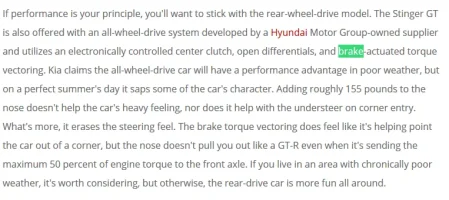
Marc Collins
1000 Posts Club!
Sharper Stinger: Testing Kia's upcoming performance-tuned AWD
I know which one I would chose if I ever drove my car off a race track or in anything other than dry weather. This one!
I know which one I would chose if I ever drove my car off a race track or in anything other than dry weather. This one!
Good find! Sign me up too. That is fantastic and very encouraging for the future of the Stinger. Haha, I am sure the drive mode would always default to Comfort though. Haha. I would have to keep setting it to Sport + for my daily drive.Sharper Stinger: Testing Kia's upcoming performance-tuned AWD
I know which one I would chose if I ever drove my car off a race track or in anything other than dry weather. This one!
westcoastGT
5000 Posts Club!
The Stinger DTV is a brake based system .......................lots of discussion here in the early days ..........you'll find it in a searchAhhhhhhh - not exactly. Yes, the AWD Stinger applies braking to alling wheels, but the AWD Stinger also applies power to wheels, which Kia calls Dynamic Torque Vectoring. By definition, Torque Vectoring means providing the differential with the ability to vary the torque to each wheel. When you throw the AWD Stinger hard into a corner, more power is transferred to the front wheels, thus pulling the car out of the corner. Same goes for launching the car hard; power is sent to the front. To say that the torque vectoring system in the AWD Stinger is a brake based system is just incorrect.
From interior to exterior to high performance - everything you need for your Stinger awaits you...


